Efficient genome ancestry inference in complex pedigrees with inbreeding
- PMID: 20529906
- PMCID: PMC2881372
- DOI: 10.1093/bioinformatics/btq187
Efficient genome ancestry inference in complex pedigrees with inbreeding
Abstract
Motivation: High-density SNP data of model animal resources provides opportunities for fine-resolution genetic variation studies. These genetic resources are generated through a variety of breeding schemes that involve multiple generations of matings derived from a set of founder animals. In this article, we investigate the problem of inferring the most probable ancestry of resulting genotypes, given a set of founder genotypes. Due to computational difficulty, existing methods either handle only small pedigree data or disregard the pedigree structure. However, large pedigrees of model animal resources often contain repetitive substructures that can be utilized in accelerating computation.
Results: We present an accurate and efficient method that can accept complex pedigrees with inbreeding in inferring genome ancestry. Inbreeding is a commonly used process in generating genetically diverse and reproducible animals. It is often carried out for many generations and can account for most of the computational complexity in real-world model animal pedigrees. Our method builds a hidden Markov model that derives the ancestry probabilities through inbreeding process without explicit modeling in every generation. The ancestry inference is accurate and fast, independent of the number of generations, for model animal resources such as the Collaborative Cross (CC). Experiments on both simulated and real CC data demonstrate that our method offers comparable accuracy to those methods that build an explicit model of the entire pedigree, but much better scalability with respect to the pedigree size.
Figures
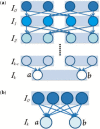
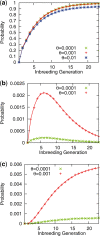
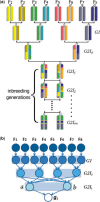

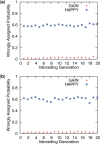
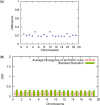


Similar articles
-
Age-based partitioning of individual genomic inbreeding levels in Belgian Blue cattle.Genet Sel Evol. 2017 Dec 22;49(1):92. doi: 10.1186/s12711-017-0370-x. Genet Sel Evol. 2017. PMID: 29273000 Free PMC article.
-
Genetic diversity analysis of two commercial breeds of pigs using genomic and pedigree data.Genet Sel Evol. 2016 Mar 30;48:24. doi: 10.1186/s12711-016-0203-3. Genet Sel Evol. 2016. PMID: 27029213 Free PMC article.
-
Measuring individual inbreeding in the age of genomics: marker-based measures are better than pedigrees.Heredity (Edinb). 2015 Jul;115(1):63-72. doi: 10.1038/hdy.2015.17. Epub 2015 Mar 18. Heredity (Edinb). 2015. PMID: 26059970 Free PMC article.
-
Inferring purging from pedigree data.Evolution. 2007 May;61(5):1043-51. doi: 10.1111/j.1558-5646.2007.00088.x. Evolution. 2007. PMID: 17492959 Review.
-
Inferring ancestry from population genomic data and its applications.Front Genet. 2014 Jul 3;5:204. doi: 10.3389/fgene.2014.00204. eCollection 2014. Front Genet. 2014. PMID: 25071832 Free PMC article. Review.
Cited by
-
Reliable genotyping of recombinant genomes using a robust hidden Markov model.Plant Physiol. 2023 May 31;192(2):821-836. doi: 10.1093/plphys/kiad191. Plant Physiol. 2023. PMID: 36946207 Free PMC article.
-
R2d2 Drives Selfish Sweeps in the House Mouse.Mol Biol Evol. 2016 Jun;33(6):1381-95. doi: 10.1093/molbev/msw036. Epub 2016 Feb 15. Mol Biol Evol. 2016. PMID: 26882987 Free PMC article.
-
Quantitative trait Loci association mapping by imputation of strain origins in multifounder crosses.Genetics. 2012 Feb;190(2):459-73. doi: 10.1534/genetics.111.135095. Epub 2011 Dec 5. Genetics. 2012. PMID: 22143921 Free PMC article.
-
A machine learning pipeline for quantitative phenotype prediction from genotype data.BMC Bioinformatics. 2010 Oct 26;11 Suppl 8(Suppl 8):S3. doi: 10.1186/1471-2105-11-S8-S3. BMC Bioinformatics. 2010. PMID: 21034428 Free PMC article.
-
The genetics of gene expression in complex mouse crosses as a tool to study the molecular underpinnings of behavior traits.Mamm Genome. 2014 Feb;25(1-2):12-22. doi: 10.1007/s00335-013-9495-6. Epub 2013 Dec 31. Mamm Genome. 2014. PMID: 24374554 Free PMC article. Review.
References
-
- Abecasis GR, et al. MERLIN-rapid analysis of dense genetic maps using sparse gene flow trees. Nat. Genet. 2002;30:97–101. - PubMed
-
- Browning S, Browning BL. On Reducing the Statespace of Hidden Markov Models for the Identity by Descent Process. Theor. Popul. Biol. 2002;62:1–8. - PubMed
-
- Chia R, et al. The origins and uses of mouse outbred stocks. Nat. Genet. 2005;37:1181–1186. - PubMed
-
- Churchill GA, et al. The Collaborative Cross, a community resource for the genetic analysis of complex traits. Nat. Genet. 2002;36:1133–1137. - PubMed
-
- Donnelly KP. The probability that related individuals share some section of genome identical by descent. Theor. Popul. Biol. 1983;23:34–63. - PubMed
Publication types
MeSH terms
Grants and funding
LinkOut - more resources
Full Text Sources
Molecular Biology Databases

